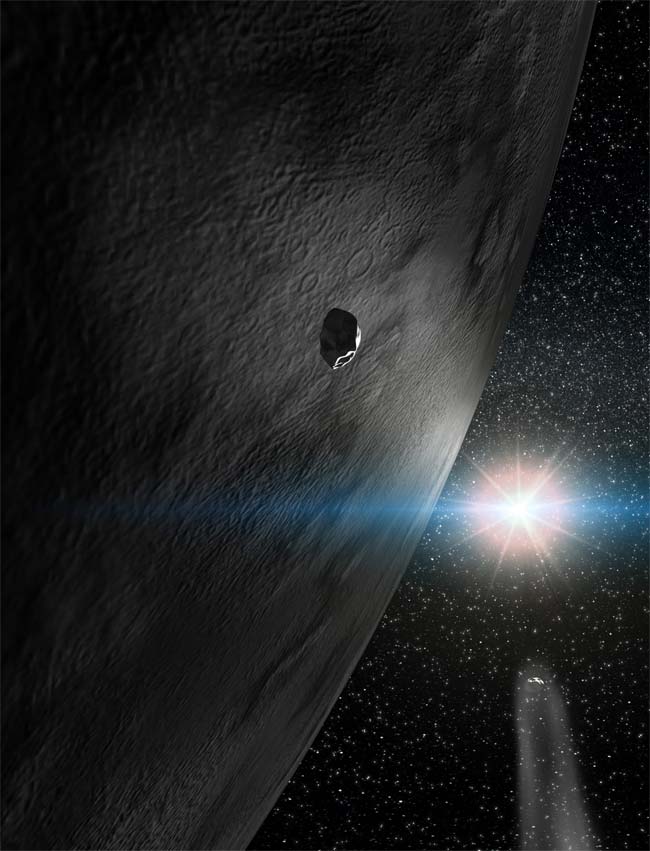Water Ice Discovered on Asteroid for First Time

Water ice has been found on the surface of a nearby asteroid for the first time ? a discovery that could help explain how Earth got its oceans, scientists announced Wednesday.
Two teams of researchers independently verified that the asteroid 24 Themis ? a large rock hurtling through space in the asteroid belt between Mars and Jupiter ? is coated in a layer of frost.
They also found that the asteroid contains organic material, including some molecules that might be ingredients for life. But scientists have not found any evidence for life itself on this asteroid, or anywhere else in the universe beyond Earth.
While comets, which have characteristic tails and generally orbit farther out in the solar system, are known to have water, asteroids in that region were thought to be too close to the sun to contain water on the surface without it evaporating away. The largest asteroid in the solar system, Ceres, is thought to harbor a vast amount of frozen water, but scientists suspect all of it is buried beneath a rocky, dusty surface.
But in this new study, researchers found concrete proof of water ice on the surface of 24 Themis by measuring the specific characteristics of sunlight bouncing off the surface of the asteroid. They saw the tell-tale signatures of H2O coating most of the surface of the 123-mile (198-km) wide rock.
Icy rock
"This is the first time we've actually seen ice ? literally H20 ? on an asteroid," said one of the study leaders, Andrew Rivkin of Johns Hopkins University.
Breaking space news, the latest updates on rocket launches, skywatching events and more!
Previously, hints that water might be present on 24 Themis were found in the form of hydrated minerals, which were thought to have formed from the reaction of water with rock. But this time the researchers saw the direct signature of water itself, he explained.
Another science team, led by Humberto Campins of University of Central Florida, found the same thing. Both teams used the NASA Infrared Telescope Facility atop on Mauna Kea in Hawaii to make their observations, but conducted them on different nights.
"Our work and their work are very nicely confirming and complementary," Campins said.
Campins' team timed their observations so that they caught the asteroid at different points in its rotation, and combined these data to create a rough surface map, showing that not only is ice present on 24 Themis, but it coats much of the surface on all sides.
"To our surprise there was water ice, there were organic molecules, and they were more or less evenly distributed throughout the surface," Campins told SPACE.com. "We thought that was fascinating."
Both teams reported their findings in the April 29 issue of the journal Nature.
Another researcher ? Henry Hsieh of Queen?s University Belfast in the U.K., who was uninvolved in either study ? noted surprise at the extent of ice coverage on the asteroid.
"The average temperatures of asteroids (about 150?200 Kelvin) at this distance from the sun should cause surface ice to sublimate away in a matter of a few years or less, which is inconsistent with the billions of years that Themis is thought to have spent at its current location," he wrote in an accompanying essay in the same issue of Nature.
Earth's water
The discovery might even provide clues about the origin of water on Earth.
Earth has had a violent history, having been bombarded with space rocks throughout much of its life. In particular, a large rock was thought to have crashed into Earth some 4.5 billion years ago, knocking off a chunk that became our moon. This collision would have heated things up so much, any water that was on Earth at that point was vaporized. So how did the oceans arrive?
Some scientists have suggested that most of it arrived via other asteroids that crashed into Earth later in smaller collisions. But for that idea to hold weight, asteroids would have to carry water. Comets aren?t a good possibility for this scenario because the water they hold tends to be of a slightly different nature, with atoms in a different configuration, or isotope, than most of the water on Earth.
Though the recent measurements can't tell anything about the isotope ratio of the water on 24 Themis, the fact that there is water there at all is an encouraging sign.
"Our data are certainly at least consistent with the idea that you could bring in plenty of water form impacts," Rivkin said.
If it sounds surprising that the vastness of Earth's oceans built up from deposits of water by asteroids, Rivkin said it isn't that crazy an idea.
"We know that the rate of [asteroid] impacts was very high," he told SPACE.com. "If each impactor, each asteroid, were 20 to 30 percent water by weight, then that could potentially add up."
- Images ? Asteroids in Space
- Top 10 Extreme Planet Facts
- Search for Water on Other Planets Leaps Forward

Clara Moskowitz is a science and space writer who joined the Space.com team in 2008 and served as Assistant Managing Editor from 2011 to 2013. Clara has a bachelor's degree in astronomy and physics from Wesleyan University, and a graduate certificate in science writing from the University of California, Santa Cruz. She covers everything from astronomy to human spaceflight and once aced a NASTAR suborbital spaceflight training program for space missions. Clara is currently Associate Editor of Scientific American. To see her latest project is, follow Clara on Twitter.
